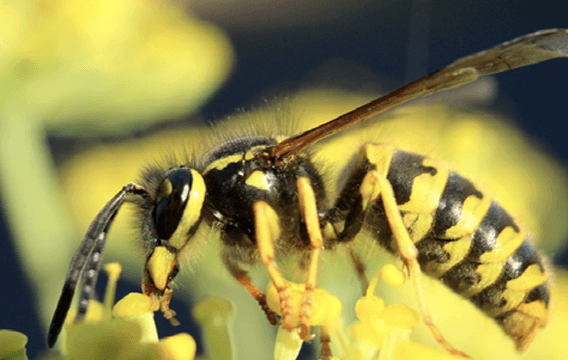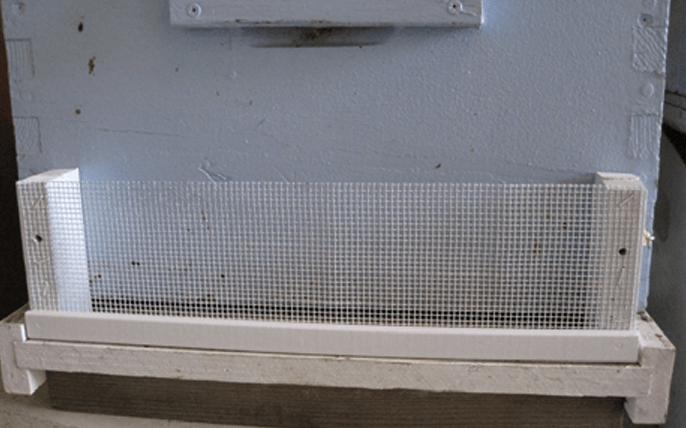Introduction
As late summer rolls around, yellowjacket wasps reliably return as unwelcome visitors to our picnics and backyard barbecues. They are also particularly troublesome to beekeepers, as they often attack honey bee colonies, carrying off both the honey bees and honey.
Despite their unpopularity with humans, yellowjackets are beneficial insects: They are important detritivores, removing dead plant and animal materials, and they are predators of many species of insect pests. Because of their important role in ecosystems, yellowjackets should not be controlled unless they are causing a stinging hazard to humans or are severely impacting honey bee colonies.
Identification
Yellowjacket (or yellow jacket) is the common name referring to wasps of the genera Vespula and Dolichovespula. Vespula pensylvanica (western yellowjacket), V. germanica (German wasp), and V. vulgaris (common yellowjacket) are common pests at outdoor eating areas in many parts of the United States. They are black with defined yellow or white markings on their bodies. Yellowjackets are approximately ½ inch long and have narrow bodies with a pinched waist. They are more angular than honey bees, and they lack the dense body hairs and furry appearance of bees, though yellowjackets do have a small number of body hairs (Figure 1).
Proper identification of yellowjacket wasps will ensure that nonthreatening, beneficial wasps or bees are not harmed in control efforts.
Life cycle and behavior
Yellowjackets are semi-social, colony-nesting insects with an annual life cycle. A colony begins in the spring when overwintered queens emerge and select a nest site. Depending on the species, a nest site may be an underground cavity, a hole or opening in a structure, or an aerial nest. The queen (or often multiple queens) will build a small nest in the cavity and begin to lay eggs that will become the first generation of workers. Initially, the queen builds the nest, feeds larvae, and forages. Once the first generation of workers emerges, the queen will remain in the nest, laying eggs.
The population of the colony will build rapidly into the summer. In late summer, the queen lays eggs that will develop into the next generation of queens. These newly emerged queens will then mate before finding a protected location for their winter dormancy period. Each of these queens will overwinter individually and emerge in the spring to head her own colony.
Unlike honey bees, which gather protein exclusively from flowers (pollen), yellowjackets acquire protein from animal sources through scavenging and predation on other insects. Carbohydrate sources include plant nectar, fruits, or honeydew (the sugary secretion of aphids).
In late summer and autumn, when prey insect populations and nectar sources are reduced, yellowjackets can become problematic for honey bees by robbing resources from colonies and predating adult bees. In dry years when nectar flows end early and the autumn dearth is extended, yellowjacket pressure on honey bees may increase. Heavy predation can lead to declines in bee population and overall honey bee colony health. Sustained predatory pressure can be particularly problematic for weak colonies and may ultimately lead to colony death.
The size of yellowjacket populations relates closely to weather patterns. If spring weather is rainy or cold, queens may not be able to establish a nest or forage for food for larvae. However, if spring is warm and dry, yellowjacket queens may be successful and produce many offspring that grow into large populations in late summer.
Control methods
If yellowjacket pressure is high and negatively impacting honey bee colonies, control methods may be attempted; however, research indicates that these attempts are unlikely to reduce the overall yellowjacket population. Methods include trapping yellowjacket workers, using poison bait to kill a yellowjacket colony, or destroying yellowjacket nests with insecticide. When dealing with an active nest or using chemicals, working with a professional service is recommended.
Traps
Traps are effective in the spring to catch queens and, later in the season, to catch workers. Because each colony can yield up to 5,000 workers at its peak, each queen caught in spring may dramatically reduce yellowjacket populations in late summer and fall. A study in California found that traps containing heptyl butyrate effectively attract queen and worker yellowjackets. However, in this study, the number of trapped queens did not reduce the number of yellowjacket workers trapped in late summer.
Traps are readily available in garden centers and hardware stores (Figure 2). If you need a large number of traps, you may wish to construct them yourself. Many designs available online are containers with small entrances to minimize exit, and some kind of attractant (dry traps). If building your own trap, it is important to avoid using sugary attractants as they could inadvertently attract bees. Other trap designs use attractant suspended over soapy water to drown yellowjackets. Attractants for these traps may include heptyl butyrate, meat, pet food, fish, or rotting fruit. Heptyl butyrate is a highly effective yellowjacket attractant and does not attract honey bees. While fresh meat or fish may also be attractive, it may spoil within hours and become ineffective.
Because yellowjackets tend to forage near the ground, you should place traps low to the ground and at least 20 feet away from bee hives so the yellowjackets don’t “discover” bee hives when investigating the traps. Replace the attractant in traps regularly throughout the season to maintain efficacy. Traps will need to be periodically emptied of dead yellowjackets, so put them in a readily accessible location.
While chemical attractant or food-attractant traps can effectively trap hundreds of yellowjackets and give a beekeeper a satisfying feeling as the trap fills, casual trapping usually will not reduce a population enough to substantially relieve pressure on honey bee colonies. After monitoring populations and determining that yellowjacket populations and pressure on honey bee colonies are high, an interceptive trapping strategy may reduce the yellowjacket population in a small area. Reierson et al. (2008) effectively reduced the yellowjacket population in a popular picnic pavilion by surrounding the pavilion with 50 traps placed 200 feet from the pavilion. They emphasize the importance of frequently replenishing traps with fresh attractant and that more traps may increase efficacy.
Poison baits
Low-concentration insecticide mixed with meat or fish bait may be an effective control measure. Yellowjackets take the bait to the nest, distribute the chemical to nest members, and the colony dies quickly. Currently, the only insecticide approved for yellowjacket bait traps is Onslaught (microencapsulated esfenvalerate); however, success is variable. Baiting yellowjackets with any other insecticide or other chemical is a violation of state and federal pesticide laws. Onslaught is available in a kit complete with traps as Alpine Yellow Jacket Bait Stations, which can be ordered online. It is important to follow label instructions for the bait stations. Adding more insecticide than prescribed may repel yellowjackets.
Finding and destroying yellowjacket nests
Before attempting to destroy a yellowjacket nest, consider calling a professional. Yellowjackets may be defensive and stings are painful. Some regions may have a local yellowjacket collector who collects adults and harvests venom for pharmaceutical use. Contact your local Extension office to find a venom collector in your area.
Yellowjackets typically forage within 1,100 feet of the nest site. Foragers can be tracked back to the nest location by dusting them with flour or powdered sugar and following them back to their nest. While some yellowjacket nests are aerial nests or located in manmade structures, they are most commonly found underground. Nests generally have small entrances (Figure 3).
Once a yellowjacket nest is discovered, spraying an approved insecticide into the colony entrance can be effective. Spray at night, when yellowjackets are inside and calm. Care should be taken in application to prevent any exposure of insecticide to people, pets and other wildlife. Follow the label carefully and wear appropriate personal protection equipment.
Preventing yellowjacket attack
Yellowjacket foragers seek protein and carbohydrate sources to feed their developing larvae. A honey bee colony offers an abundance of both these resources and hence will attract yellowjackets. Beekeepers can protect their honey bees from yellowjacket predation with good beekeeping practices such as keeping strong colonies, reducing hive entrances, installing robbing screens, and maintaining a tidy apiary. Because it is often impossible to remove all the yellowjackets in an area, apiary and colony management are generally the most effective methods of keeping honey bees safe from yellowjacket predation.
Keep strong honey bee colonies
Yellowjackets are opportunistic and will tend to pick on colonies that are smaller or weakened by mites, disease, hunger, etc. Strong honey bee colonies will have plentiful guard bees to fend off yellowjackets; therefore, beekeepers should maintain colony health and combine weak hives into fewer strong colonies before they deteriorate to a vulnerable state. Keep colonies strong by keeping Varroa mite levels and other pests and diseases under control. Ensure that honey bee colonies have ample resources. Feed bees carbohydrate (sugar syrup) and protein (protein patties) when necessary, while taking care in cleaning up any spilled syrup or patty remnants.
Limiting physical access to colonies also plays an important role in helping bees fend off yellowjackets. Woodenware should be maintained in a good state with no gaps between boxes. Entrance reducers minimize the space guard bees need to defend. If you need to reduce entrances and temperatures are high, use mesh screens that prevent intrusion but allow for adequate ventilation.
Robbing screens (Figure 4) allow resident honey bees to enter and exit the colony, while deterring yellowjackets from entering.
Maintain a tidy apiary
Minimize debris in an apiary which may attract yellowjackets and incite predation. Wax scrapings and other material accumulated when cleaning frames, feeders, and bottom boards should be collected and disposed of off site, particularly when they contain brood and dead bees.
During periods of dearth, use extreme caution when feeding: carefully pour syrup to reduce spills and clean up spilled syrup immediately. Yellowjackets can quickly detect sweet odors and will seek the carbohydrate source.
Robbing behavior among honey bee colonies can be a problem, particularly during nectar dearths, and can also increase problems with yellowjackets. Robbing behavior by honey bees leads to fighting between individual bees, and dead bees end up scattered near the entrance of the hive. The presence of dead bees can attract scavenging yellowjackets and lead to increased pressure. To minimize robbing behavior, keep colony inspections short and do not leave boxes open or frames exposed. Feed late in the day and clean up syrup and honey spills immediately.
Keep other potential food sources out of your apiary. Rotting fruit from berry bushes or fruit trees will attract yellowjackets to the area, as will picnic or barbecue fare.
We need our bees and our wasps
Yellowjacket wasps play an important role in many ecosystems. They are predators to common pest insects, and they are also scavengers, cleaning up decaying animal material and detritus. Unfortunately for honey bees and their keepers, yellowjackets find a bounty of resources in a honey bee colony. By maintaining strong honey bee colonies, practicing good beekeeping habits, and keeping apiaries clean, beekeepers can reduce yellowjacket predation on honey bees without destroying these important predatory insects.
For more information
Landolt, P. J. and A. L. Antonelli. 2003. Yellowjackets and Paper Wasps. EB0643. Washington State University Cooperative Extension.
University of Minnesota Bee Lab. 2014. Bothered by Bees or Wasps?
¡Use los pesticidas con seguridad!
- Póngase ropa de protección y equipo de seguridad según las recomendaciones de la etiqueta. Báñese después de cada uso.
- Lea la etiqueta del pesticida—aunque lo haya usado antes. Siga al pie de la letra las indicaciones de la etiqueta (y cualquiera otra indicación que Ud. tenga).
- Tenga precaución al aplicar los pesticidas. Conozca su responsabilidad legal como aplicador de pesticidas. Usted puede ser responsable de heridas o daños resultantes del uso de un pesticida.



